Engineering: The route to problem-solving
Young researchers learn how math and science are used in the real world, from protecting eggs to delivering tap water
By Helen Fields
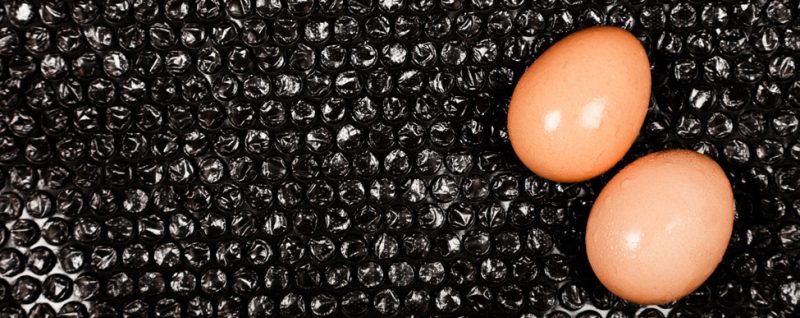
The delicate egg hatched some heavy discussion among the five young scientists inspecting a pile of squishy packing materials. “So, bubble wrap?” asked Samuel Coulson, 14, of West Platte High School in Weston, Mo.
The team, working with only the materials at hand, had to devise a way of protecting a raw egg from a series of increasingly higher drops. The challenge pit these students against five other teams at the second annual Broadcom MASTERS competition. It was held in Washington, D.C., from Sept. 28 through Oct. 3.
As the team pondered its options, some plastic wrap burst with a satisfying sound. “Stop popping it,” said Maria Elena Grimmett, 13, from Oxbridge Academy of the Palm Beaches in West Palm Beach, Fla.
The 7th- to 9th-graders qualified as finalists in the competition based on a science fair project from the previous academic year. But that project would count for only one-quarter of each contestant’s score here at the finals. The majority of each score would reflect how well a student performed in a series of group challenges — including the egg drop.
“Guys, I seriously think packing peanuts, due to the fact that they actually slide against each other,” suggested Chase Lewis, 13, who is home-schooled in Chapel Hill, N.C.
The team events would award creativity and cooperation as the students spent a long weekend together brainstorming solutions to various challenges. At stake: national bragging rights and a top educational award of $25,000. Additional awards would go to participants who demonstrated great innovation and outstanding performance in applying science, technology, engineering and mathematics (or STEM).
“We’re just going to have bubble wrap as the outer layer,” declared Daniel Lu, 13, from Concord-Carlisle Regional High School in Concord, Mass. “Then we can fill the rest up with packing peanuts.”
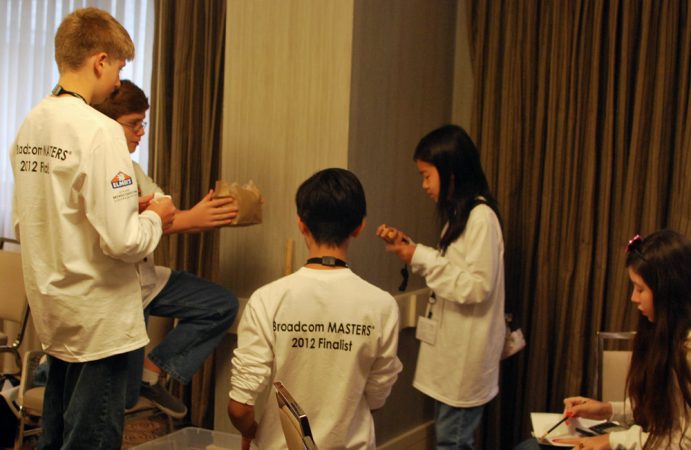
And in the end, that’s what the White Team did. On Monday, Oct. 1, the four, along with Anna Lou, 12, from Oxford Academy in Cypress, Calif., layered the inside of a brown paper lunch bag with packing peanuts and bubble wrap. The layers cocooned a zippered plastic bag filled with more packing peanuts — and a single egg. The team then dropped the egg from waist-height. Would it survive the fall?
E is for engineering
This year’s Broadcom competition focused on engineering. Engineering means using math and science to design new things or to solve practical problems — such as cushioning a dropped egg.
As Samuel held out the White Team’s egg and let it drop, his teammates timed its fall. The students all remained confident the egg would land intact. Later, the team would use the time and the distance the egg fell to calculate how fast it was traveling when it hit the floor.
The competition gave the students a sense of the many different types of engineers. Software engineers, for instance, design computer programs. Structural engineers may design a bridge to handle heavy loads, to span especially long distances or to withstand harsh conditions. Chemical engineers create new foods or fuels. And civil engineers design sewers, tunnels, buildings and other structures that we reply upon in everyday life.
“Thunk!” The White Team’s egg hit the bottom of a plastic bin on the carpeted floor of the hotel where the competition was taking place. The five expectantly peered inside: The egg had survived!
Among the many problems that engineers tackle, protecting eggs is one that most consider pretty much solved. Egg cartons work well, and most people take care not to drop eggs anyway. Still, the egg drop provides a good challenge for young engineers — especially as the height increases.
For the second drop, the White Team had to release its egg from a height of about 6 feet (1.8 meters). Chase climbed onto a chair, held out the egg and let go. Would the egg survive this time?
The Broadcom finals challenged the competitors to think of the egg drop as analogous, or similar, to a car crash. Engineers design automobiles to protect the people inside, just like a paper bag filled with packing peanuts and bubble wrap can protect an egg.
Unfortunately, the White Team’s second drop didn’t end so well for the egg: “It broke into so many pieces!” Chase moaned. On the next try, the students added more bubble wrap, which solved the problem.
To reinforce the crash analogy, the six teams started the egg drop challenge by watching two videos from the Insurance Institute for Highway Safety. This organization studies how to keep people safe during car crashes. The videos showed crashes created under laboratory conditions. The vehicles contained no real drivers or passengers.
In the first video, a car ran into the back of a truck, but the crash wasn’t too bad. In the second video, the same type of car ran into the same type of truck. This time, the car was nearly destroyed as a portion of the truck pierced the car’s windshield — right where the driver’s head would have been.
Just like that second crash, not every egg drop turned out well. Eventually, the White Team figured out how to protect an egg enough to allow it to survive a drop from nearly 8 feet (2.4 meters) above the ground. All the other teams protected their eggs too — although not always on the first try.
To help the Broadcom MASTERS finalists understand how apparently similar crashes could turn out so differently, the Insurance Institute provided detailed measurements from the collisions it had conducted. The finalists then used these data to understand some critical differences. For instance, in the second crash, the car was traveling 10 miles (16 kilometers) an hour faster. Using this information, the students calculated how much harder the car struck the truck in the second crash. Then, each team applied the same principles to calculate how dropping their eggs from different heights would affect their speed.
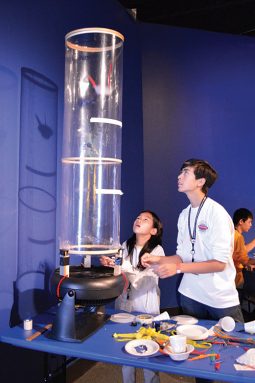
Julio Vargas, president of the Washington, D.C., chapter of Engineers Without Borders, speaks to members of the Red Team. He and his colleagues walked Broadcom MASTERS finalists through some of the math required in getting water from an elevated holding tank to homes. Jessica Kirsh (IML Photography) / SSP - Students participate in a wind tunnel challenge at the Maryland Science Center in Baltimore. Engineers on site helped walk Broadcom MASTERS finalists through several activities. Credit: Patrick Thornton/SSP
Engineering safer conditions
Probing the dynamics of crashes (or drops) and how to limit damage is a good example of engineering. On the Sunday of the Broadcom finals weekend, engineer Julio Vargas offered others.
Vargas is president of the Washington, D.C., chapter of Engineers Without Borders. His group helps people in developing countries. In the last few years, his chapter has worked with people in Santa Clara, a rural town in the Central American country of El Salvador. Together, they are helping to bring clean drinking water to homes there.
The simple goal required some complicated engineering. The engineers first had to decide how to clean the water they retrieved from a well. Then they had to pump it uphill into a water tank. The engineers also had to design a system to distribute the stored water to about 400 separate households. Vargas and his coworkers spoke to the Broadcom finalists during a field trip to the Maryland Science Center in Baltimore. The engineers reviewed some of the math they used in figuring out how to distribute the water from the elevated holding tank to all of those homes.
Water leaving the holding tower runs downhill. But if the tower isn’t high enough, the water won’t leave it with enough energy to reach each home. So the engineers used a gauge to measure the water pressure at different heights. During the Broadcom MASTERS competition, student researchers simulated the problem using two buckets, some tubing and a stepladder.
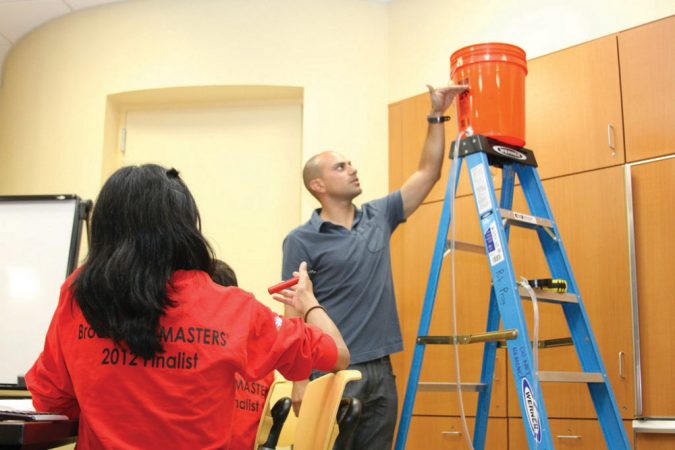
“I had no idea that giving water to a city involved so much math,” said Varun Iyer, 14, a Purple Team member from Springfield High School in Illinois. Through this exercise, he noted, “I learned how you can use math in the real world.”
STEM’s least understood component
Varun is already well on his way to becoming an engineer — you could say it is a family tradition. His parents are software engineers, an uncle is a mechanical engineer and his grandfather was a civil engineer. Young Varun is interested in biomedical engineering. One day, he mused, he might design robots that help surgeons make precise cuts on delicate organs. He suspects even his little sister might join the profession. “She’s pretty good at math,” he said, and “likes science a lot.”
The Broadcom MASTERS focused on engineering in part because many young people don’t know what it is. Vargas explained to the finalists how he became interested in engineering when he happened to take a drafting class in high school.
Drafting involves the precise drawing of very detailed plans that others can use to build things, such as machines or buildings. Vargas began drafting using pencils and paper. Today, most engineers use computers. His early start in drafting inspired him to study engineering in college.
“Engineering is the ability to decipher a problem or need and come up with a solution,” Vargas explained. For example, Vargas works at IBM, where he makes sure that the computers people use to check in at airports are safe. Those computers may not seem dangerous, but that’s because of people like Vargas. A computer “could fall on you, it could shock you, it could have a sharp edge. It could fail and start a fire,” he said. So Vargas anticipates every possible way a computer might hurt you. He then designs ways to reduce the chance that any of those might happen.
Elizabeth Hubler, a student at George Washington University in Washington, D.C., also attended the Sunday event to share the joys of engineering with the finalists. Hubler is in her third year of college and majoring in mechanical engineering. Mechanical engineers design, build and run all types of machines. Hubler got interested in engineering in high school while competing with other young people to build robots that met certain challenges. “I was like, oh, this exists? That would be really cool to study in college!” Hubler said. Now she and a professor study how air flows when you talk — and how that changes when there’s a problem with your vocal cords.
Engineer Shane Lansing lives in California, but flew across the country to tell the young researchers about careers in engineering. Lansing works at Broadcom, the company that sponsors the MASTERS competition. There, he directs a team that designs the computer chips used in all types of communications devices, including the Wii video game console and iPhone.
“I loved being the kid that was always solving the math problems that none of the other kids could solve,” Lansing said. Work still offers that kind of competitive excitement, he said. In fact, most of his coworkers have held onto their childhood enthusiasm for problem solving, Lansing explained. Even as grownups, the Broadcom employees still tinker with things and play video games.
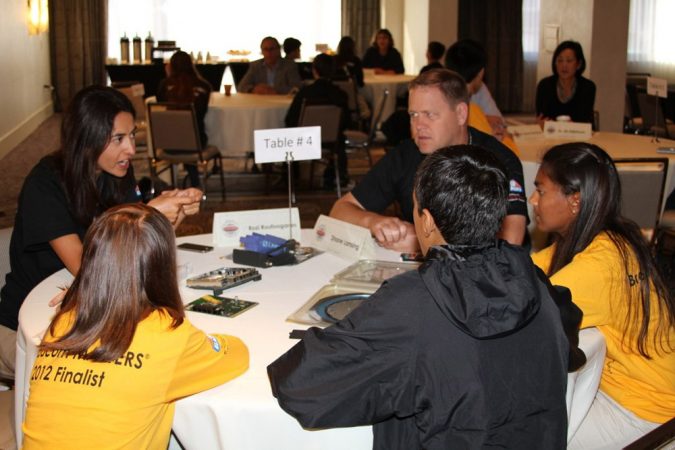
If you’re interested in engineering, play can be a great place to begin, Vargas said. “Buy a Lego set and just start experimenting,” he recommended. “That’s what I did.” Vargas would start by following the instructions. “Then I’d take it all apart and build it the way I wanted to build it.” Eventually, he would build something better — just as an engineer would.
Power Words
biomedical engineer An expert who uses science and math to find solutions to problems in biology and medicine; for example, they might create medical devices such as artificial knees.
civil engineer An engineer who creates buildings, tunnels, water systems and other large projects that improve everyday life.
computer chip (also integrated circuit) The computer component that processes and stores information.
developing country A poorer country with relatively little industry and a lower standard of living than industrial countries, such as the United States and Canada.
drafting The creation of detailed plans or drawings that others can use to build something.
engineering The use of math and science to solve practical problems.
mechanical engineer An engineer who designs, builds or operates machines.
modem An electronic device that connects your computer to the Internet.
pressure gauge A device that measures pressure.
software engineer An engineer who designs and works with computer programs.
vocal cords Two folds in the human throat that vibrate to produce your voice.